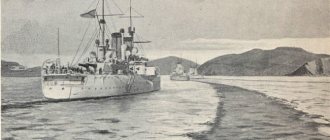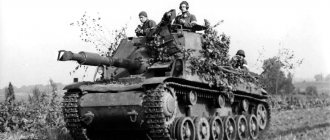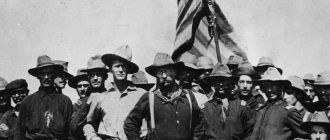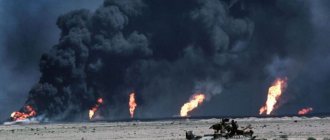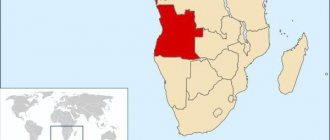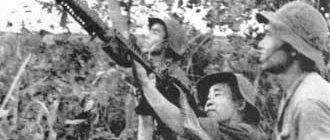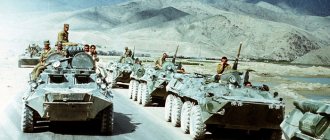The armed conflict between the Georgian military forces and the militia of the Abkhaz people that occurred in 1992-1993, also called the “Patriotic War of the People of Abkhazia,” claimed many lives, both military and civilians.
The main reason for the conflict was the civil war in Georgia in 1991. The entry into the territory of Abkhazia and the attempt to seize territories controlled by the Sukhumi authorities by the Georgian National Guard turned into a series of bloody battles. During the year, both sides conflicted without a strong preponderance of forces and victories of one of the parties. The united forces of volunteers of the North Caucasian peoples acted against the Georgian military who invaded foreign territory.
According to numerous statements by the warring parties, their opponents have repeatedly violated and ignored human rights, carrying out punitive operations and the destruction of civilians. A group of UN missionaries sent to the conflict site claims that violations were observed on both sides.
After the cessation of the fighting, vast territories were devastated, and more than one hundred thousand civilians living there were forced to leave their homes and flee abroad.
In 1994, a ceasefire agreement was signed. UN envoys and Russian troops were sent to the conflict zone to maintain the peace regime and help the victims.
The reasons that started
In April 1991, Georgia, led by the chairman of the Supreme Council Zviad Gamsakhurdia, declared its independence. After this, active actions began to be taken to eliminate the Abkhaz and South Ossetian autonomy.
The civil war that raged in Georgia in 1991 led to Gamsakhurdia being overthrown as president in January 1992. The officials in power invited Eduard Shevardnadze to the post of president, hoping that his political influence would help keep power in the hands of the new government.
Shevardnadze returned to Georgia and headed the government that overthrew the previous president. However, not all territories of the country were in the hands of the then-current Supreme Council; Megrelia and Samegrelo were controlled by the Zviadists. South Ossetia, Abkhazia and Adjara did not recognize the new government, and on the territory of the City of Zugdidi there were battles with supporters of the overthrown President of Georgia.
Creation of new authorities
The Council of National Unity of Abkhazia was created in the city of Sukhumi. It included important political figures, intellectuals and representatives of labor movements, and its role was to resolve disagreements with the Georgian side and prevent the usurpation of power.
The desire of the Abkhaz people to restore the 1925 constitution caused disapproval from the Georgian authorities. They tried to cancel this political step of the autonomous republic, in response to which, deputy Z. Achba announced the illegitimacy of the State Council and their decision would not be taken into account.
Supporters of the former president, located in the region of Megrelia, Zviad Gamsakhurdia, added fuel to the fire; in the region of western Georgia and Samegrelo, they staged terrorist attacks in the west of the country and kidnapped political supporters of Shevardnadze.
On August 10, 1992, Georgia decided to introduce military forces into the territory of the autonomy in order to free the hostages and control the railway lines along which Russia and Armenia carried out trade.
Here is how Tbilisi, former Minister of Security of Georgia Igor Giorgadze comments on this move: “Protecting trade routes was only a pretext for starting a war. Shevardnadze claims that his order was misunderstood, although everyone understands that the reason was the precariousness of his power. What could you count on when you send an undisciplined army with armored vehicles into a zone of possible conflict? This was a deliberate step, for which he decided to place the blame on Abkhazia.”
War
Invasion
Georgian troops began fighting the Abkhaz at the peak of the holiday season. Two thousand soldiers and almost sixty pieces of military equipment under the command of Tengiz Kitovani crossed the border under the pretext of protecting the railway. Most of the equipment went to Georgia after the collapse of the USSR.
Certain leaders in Russia knew about the future invasion, and provided Shevardnadze with support from the air, sea and land. They were provided with almost a quarter of a thousand tanks.
The key parameter of the Georgian plan, codenamed “Sword,” was the factor of surprise, which could allow for the rapid seizure of Sukhumi territories. The troops moved along the Zugdidi-Sukhumi highway, the main routes of communication were blocked, so that the Abkhaz leadership remained in the dark for as long as possible.
The first aggressive actions were a clash in the Ochamchira region and a landing on the Abkhaz-Russian border. The main purpose of these actions was to encircle autonomy and limit its contact with neighbors.
The military did not immediately invade Sukhumi, but tried to negotiate, in which senior officials from both sides took part. But it was not possible to reach a consensus and a bloody battle took place in the Red Bridge area. The Abkhaz troops were armed with firearms, and the only equipment they had was homemade armored cars. The superior forces of the Georgian troops, having an advantage in strength, occupied Gagra.
The ruling elite of Abkhazia was forced to relocate to the Gudauta region. There they received support in the form of provisions and weapons. In addition, numerous volunteers represented by Adyghe and Chechens expressed a desire to help the fraternal people. They organized independent military units that were supposed to resist the Georgians.
Help from neighbors
One of the commanders-in-chief of the Chechen units was Shamil Bosayev. He performed well and was appointed commander of the troops based near Gagra. He was also appointed Deputy Minister of Defense of Abkhazia. On the Adygea side, volunteers under the command of Sosnaliev played a special role. For the deeds that brought victory to the Abkhaz people, he was awarded and received the title of “People's Hero of Abkhazia”, and was also appointed Minister of Defense.
The Russian leadership was well aware of the gathering forces coming from the North Caucasus, but they did not act.
In August 1992, the borders between Abkhazia and Russia were closed to avoid a large wave of refugees. The Russian side organized the supply of supplies and medicine to the conflict zones, and more than 15,000 civilians were evacuated by sea.
Counter attack
According to Shevardnadze, none other than the current Russian President Boris Yeltsin was interested in a peaceful end to the conflict. On his initiative, the offensive was stopped on August 31, 1992. Many Georgians perceived this as an act of cowardice and betrayal on the part of their leader.
In October, Abkhaz troops launched a retaliatory offensive. Their military power was strengthened by captured missile launchers. They were able to recapture Gagra and gain a foothold at strategically important points. Basayev’s troops played a major role in this operation, whose actions were criticized throughout the world. According to eyewitnesses, he organized brutal punitive raids, his troops destroyed civilian families, both Georgian residents and Russians.
Gia Karakarashvili, who was the commandant of Gagra, became famous among his compatriots for resisting and making an appeal on television. In his speech, he stated that if the attackers did not retreat, he would destroy every Abkhazian without exception.
Having captured Gagra, the Abkhaz troops established food channels with the Union of Caucasian Peoples supporting them. In the city they acquired several dozen military equipment. Georgia accused Russia of supporting the separatist movement, to which it was said that all weapons and equipment were captured.
Horrifying articles surfaced in the news papers claiming that Abkhaz troops played football with the severed heads of Georgian soldiers after capturing the city. But the source could not confirm the authenticity of the information.
Russian participation
There were several Russian military units on the territory of Abkhazia, including a unit supporting the operation of the airfield in Gudauta, a military laboratory in Nizhnye Eschery and an airborne battalion in Sukhumi. According to the Russian government, the units performed only peacekeeping missions such as delivering medicine and removing refugees, but Georgia has repeatedly stated that they were carrying out intelligence operations in favor of Abkhazia.
In fact, Russia remained neutral in this conflict, but Russian soldiers were still attacked by the Georgian armed forces and were forced to attack in response. It was repeatedly stated that self-defense, with which they covered themselves, was only a pretext for conducting armed actions.
The main and decisive battle in the Georgian-Abkhaz conflict was the battle for Sukhumi. Violating the peace agreement, Abkhaz troops attacked the city and captured it. The defeat and the need to evacuate more than 250,000 Georgian civilians had a significant impact on the country.
During the conflict, it was on the verge of a civil war that was coming from the west of Georgia. Supporters of the ousted President Gamsakhurdia accumulated power and wanted to return the illegally taken power to their leader.
Shevardnadze had to turn to Russia for help, which “recommended” the Abkhazians to accept the peace proposal and end the conflict.
What did the Georgian-Abkhaz war show?
Exactly 26 years ago, Georgia tried to use brute force to end the autonomy of Abkhazia in order to lose it forever
On this day exactly 26 years ago, the Georgian-Abkhaz war began, on the initiative of Tbilisi. This was an aftershock of one of the largest catastrophes in world history - the collapse of the USSR, on the territory of which a small empire, Georgia, existed and flourished from the moment it joined Russia. In Soviet times, it was a showcase of a large country. The Georgians, who had numerous representatives in Moscow in the highest echelons of power in different years (Stalin, Beria, Ordzhonikidze, Georgadze, Shevardnadze, etc.), had a unique status in the USSR. At the expense of the entire country, and especially its Russian part, they were created unprecedented living conditions and a standard of living that was five to six times higher than the Soviet one, and were also allowed to have “autonomies”, which Tbilisi ruled in a tough style.
Abkhazia was the pearl among them. The times when its ruined lands, in which Russian garrisons were mercilessly mowed down by fever, are long gone. The terrible swamps were drained in tsarist and Soviet times, after which Abkhazia turned into a continuous resort area of national importance. It was fashionable among the Georgian elite to have dachas in Abkhazia. Georgians looked down on the local population, considering them primitive, lazy, and incapable of higher culture. The Abkhazians also did not like Georgians and constantly asked to go to Russia, but to no avail. However, when Georgia, favored most of all in the USSR, was one of the first with a scandal to leave the still existing country, a large empire, the Georgian “minorities” - Abkhazians, South Ossetians and even Adjarians (pure Georgians, but Muslims) - realized that different times were coming. Since now Moscow will no longer be able to protect their elementary interests from attacks by Tbilisi. And that regardless of whether Russia now takes them in or not, they do not want to stay in Georgia. At least, that’s what the Abkhazians and South Ossetians thought. Thus, this formally united country, a small empire, like the USSR, cracked. Only in this case along the boundaries of autonomy. Tbilisi, naturally, did not recognize this, and waited for an opportune moment to force their “vassals” to submit.
Clouds are gathering
In August 1992, the confrontation between the Supreme Council of Abkhazia and the leadership of Georgia, where local criminals had recently overthrown its first crazy president Zviad Gamsakhurdia, which his Mingrelian fellow tribesmen did not accept, reached the point of no return. The Georgian-Abkhazian war began (1992-1993). Georgia, led by world-famous Eduard Shevardnadze, needed a “small victorious war” to unite Georgians around a patriotic goal. At the same time, this was an excuse to carry out a predatory raid on Abkhazia in order to profit from the property of its non-Georgian population, which was also one of the ways to show him his new place. The main emphasis was placed on the surprise and audacity of the attack.
Having declared independence from Russia, Georgia doomed itself to everything that happened to it later. Photo: Joseph Davitashvili, Givi Kikvadze Givi / TASS
At that time, Georgia, in fact, did not yet have a regular army, but the country had several irregular military formations and many who wanted to take part in the raid, as well as numerous ex-Soviet warehouses with weapons, which were more than enough. As former Georgian Security Minister Igor Giorgadze later recalled, “rabble” were introduced into the defunct autonomy, and Shevardnadze “knew perfectly well that shooting, massacre, massacre would begin there - and he deliberately went, turning all the arrows to Abkhazia.”
Thus, everything was at stake. Anyone who knows the Caucasus understands that such things are not forgiven there. Yes, they shed the blood of others and their own abundantly, both sides behaved ugly and cruelly in many cases. But it was important who started, who started the chain of blood feud. And even more important was who would win. Because the winner will receive everything - not only all the rights for himself, but also the land of the vanquished, the land cleared of them. And for a long time, for centuries, because even after many generations, mothers will tell their children a version of these events that is beneficial for one or another people. Georgia took a great risk by undertaking this adventure. She was unlucky because as a result she was completely deprived of what she wanted to assert her power over.
How it was
The invasion began at the height of the holiday season - two weeks after Georgia was admitted to the UN. It was a planned action, the success of which the Georgians had no doubt about, since they gave it the code name “Sword”. Troops of the Georgian National Guard walked ahead, or rather rode in cars, trucks, armored personnel carriers and tanks, anticipating an easy walk. The offensive was supported by the Air Force and Navy, which on August 15 landed Georgian troops in the Gagra region, closing the border with Russia for the Abkhazians. At this time, the main forces were moving, without meeting resistance, along the Zugdidi-Sukhumi highway. It seemed to the Georgians that they had encircled Abkhazia, that they had succeeded. They had already begun to share the skin of the bear that had not yet been killed: they broke into the houses of local residents, robbed them, which was witnessed by Russian tourists. Such scenes occurred even in Leselidze - on the very border with Russia. The aggressors behaved impudently not only towards the Abkhazians - they also perceived the Russian garrisons stationed in Abkhazia since Soviet times as a hostile force, which forced Moscow to give the order to respond to fire with fire, which, naturally, turned out to be much more effective than the Georgian one.
What was expected to be an easy stroll through Abkhazia turned into a protracted military conflict with catastrophic consequences for the Georgians. Photo: Irakli Chokhonelidze / TASS
Russian military factor
The fate of the Russian military at that time, half-forgotten by Moscow, eking out a miserable existence in Abkhazia, Georgia and other parts of the former Soviet empire, who survived as best they could, including at the expense of the huge warehouses of weapons they guarded, cannot be envied. In a sense, they found themselves in the position of the British when British India was divided into two states - India and Pakistan, which immediately began to fight each other, at first together with British officers in their armies, which just yesterday were one whole - the Anglo-Indian army. Something similar happened almost half a century later with the Russian military.
Both before and now, Georgians accuse Russia of being so worthless that, instead of returning former vassals chained to Georgia, it helped their opponents. This is not true, or rather, a half-truth. The Russian units located in Abkhazia really focused on the local authorities, without which they could not survive. The Russian units remaining in Georgia, guarding the colossal warehouses of the Transcaucasian Military District, which ceased to exist on January 1, 1993, naturally focused on the Georgian authorities.
The Georgians, whom the Russians of the USSR times not only respected, but idolized, admiring their culture, art and ability to live beautifully, had a great opportunity to get along with our military. To do this, it was only necessary, in turn, to treat them with at least minimal respect, and not engage in expropriations, not bomb or shell military bases and even sanatoriums. Thus, the arrogance and arrogance of the Georgians, from whom only a smile was required, became one of the factors of their further defeat in the conflict with the Abkhazians. Another thing was the readiness of the latter, who well understood what fate was destined for them in the new Georgia, to resist. The most important factor in the victory of the Abkhazians was the solidarity with them of the mountain peoples of the North Caucasus and even the Cossacks, volunteers from among whom, at the call of their hearts, rushed to their aid from Russia. Considering the state of the country at that time, it was very problematic to prevent this. And finally, since the time of Lermontov it has been known that military prowess is not one of the strengths of the Georgian people, if we take it as a whole. This factor was also ignored in Tbilisi.
If someone, after all this, says that Russia is to blame for everything, then this will, of course, be a completely modern formulation of the question: Russia today, as we know, is to blame for everything. But this will not be true.
What happened next
However, capturing the coastal strip of Abkhazia was not enough. The quickly formed detachments of local residents retreated into the mountains hanging over the transport arteries, which they could easily cut. Very quickly they acquired weapons, mostly capturing them from the Georgians. Already in October 1992, the Abkhazians and their North Caucasian allies went on the offensive. The city of Gagra was recaptured from the Georgians, which initially arose as a Russian fortress that defended the Abkhaz principality, which voluntarily became part of Russia in 1810, from raids by pro-Turkish highlanders. There, the Abkhaz forces received huge trophies. Having then established control over the territory between Gagra and Russia, they began an attack on Sukhumi. The Georgians repulsed two attempts to capture the city, but failed the third.
The Georgians fought courageously for Sukhumi, but were unable to hold the city; their bitter opponents did not forgive them for this. Photo: TASS
This happened despite Russian diplomatic intervention to quell the conflict. The truce signed between its participants collapsed. The Georgian army found itself completely surrounded in Sukhimi and could not hold the city. To avoid massacre by the embittered enemy, the Georgian military desperately defending Sukhoi had to be taken out of the port city by the Russian Black Sea Fleet. Moscow also saved the head of Georgia, Shevardnadze, who was there. On September 27, Sukhumi became Sukhumi. Some of those Georgians who failed to evacuate had to pay with their lives for the failed campaign. By September 30, the entire territory of Abkhazia was cleared of Georgian military formations, except for the Kodori Gorge.
It took another adventure by Tbilisi - an attack on South Ossetia in August 2008 for Georgia to lose it too. That year, after Georgia’s attack on South Ossetia, Russia recognized the independence of Abkhazia, which several other countries subsequently did, despite Tbilisi’s claims that it was “territory occupied by Moscow.” After the end of the Abkhaz-Georgian war of 1992-1993, 250 thousand ethnic Georgians fled from Abkhazia. True, approximately 70 thousand of them returned to Abkhazia within several years, mainly to the Gali region, where they previously lived compactly. Many of them, however, left Abkhazia again after the situation worsened in 1998.
By the way, the disaster in Abkhazia led in hot pursuit to a riot against Tbilisi in Megrelia - the homeland of ex-President of Georgia Gamsakhurdia. With the help of Russia, the Georgian authorities barely managed to suppress this rebellion - the threat of a full-scale civil war in Georgia receded.
Let's sum it up
The armed conflict in Abkhazia in 1992-1993 led to the death of at least about 10 thousand people, half of whom were Georgians. And about 700 more Abkhazians were subsequently blown up by mines left behind by the war. Hundreds of thousands of human destinies were broken. Material losses were also enormous, at least over 10 billion dollars. Finding itself under an economic blockade, including from Russia, Abkhazia, however, went through difficult times and now, with the help of Moscow, is building its future - separately from Georgia. And this is a given that cannot be ignored, first of all, by Tbilisi. If, of course, they are ready to learn from their mistakes.
Results of the conflict
According to official data, the Georgian-Abkhaz war claimed approximately 4 thousand Georgians and the same number of Abkhazians. Mines left behind by the fighting killed another 700 people. The economic losses of the autonomy amounted to approximately 10 billion US dollars.
Almost a quarter of a million people were forced to leave their homes and flee Georgia.
For the next five years, the autonomy was in a state of blockade, both from Georgia and from Russia.
Only in 2008 did Russia recognize Abkhazia as an independent republic and establish diplomatic relations with it.
Sad results of the Georgian-Abkhaz conflict
250 thousand ethnic Georgians became refugees. In subsequent years, only 70 thousand of them returned. At the time of the collapse of the USSR, 240 thousand Georgians and 93 thousand Abkhazians lived in Abkhazia, and in 2003 - 94 thousand Abkhazians and 46 thousand Georgians. Ukrainians and Greeks, almost half of Russians and Armenians, completely left Abkhazia. 4 thousand Georgians (according to some sources up to 10 thousand) and 4 thousand Abkhazians died. Thousands of people on one side and the other were injured and became disabled. The lives of hundreds of thousands of families were destroyed. The economy of Abkhazia suffered damage amounting to more than $10 billion.
Note. On August 9, 2008, Georgia committed aggression against South Ossetia. Obviously, the war with Abkhazia did not teach her anything. Abkhazia immediately began an operation to liberate the Kodori Gorge from Georgian troops. Georgian troops were surrounded and completely expelled from Abkhaz territory.
Russia recognized the independence of Abkhazia on August 26, 2008.

